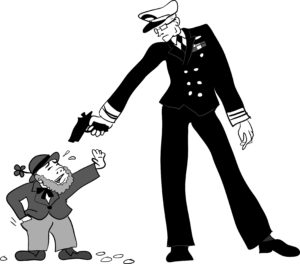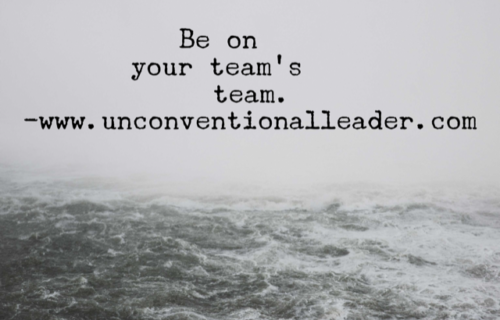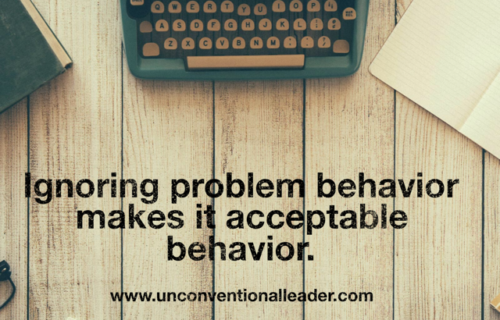How To Be On The “They” Team

We all have a “they” team that we hate. You know what I’m talking about. The “they” at work that give us too much work, boss us around, and subscribe us to the jelly of the month club in lieu of a bonus. My first indoctrination into being on the “they” team was during a performance review with one of my team members. I had really gone to bat for this person to get him as high of marks that I could but, even still, it wasn’t enough for him. He combatted me on everything that I was debriefing and all I could think in my own confusion was, “How could he turn on me like this when I worked so hard to get him these marks?” It was then I realized that, no matter how much I empathized with my team, served them, and thought of myself as an “us” team member, I was on the “they” team. It was an important lesson to learn early on because not knowing can cause some problems in getting things done.
Several years later I had to hire a Regional Chief of Police for my security organization. It was a large job. I had been “dual hatted” for about a year in filling that position and the Director of Security position. We had gone through some major overhauls during that year in how we did things, who did them and in training a workforce that were nearly 50% new hires. There were many loose ends to clean up and I needed just the right person. Someone who knew how things worked and would be able to help fulfill all the changes we had worked so hard to get going. Then, I met him! His name was Pat. He was just getting ready to retire from being a police officer with one of the local cities, was a Security Officer in the Navy Reserve and was intimately familiar with the organization and how things were supposed to be run in a Navy security department. But, there was just one problem, Pat had never made the transition to the “they” team. It wasn’t anything I could detect in his interview or in how he carried himself. However, when he got on board, he immediately joined the ranks of the “us” team in complaining about “they” changes, bucking authority and, generally, being part of the problem and not the solution.
Now, don’t get me wrong. I love the “us” team. I was an “us” person long before I got on the “they” team. And, even when I was on the “they” team, I had my own “they” team that I didn’t like. Truth be told, I actually like the “us” better than the “they” and I am more prone to be a “we” person. I think “we” get more done than either us or they.
If you’ve been feeling the “us” and “they” pain, there are things you can do (and Pat could’ve done) to keep the divisions between them small and to create more of a “we” environment (with the realization that you are still on the “they” team).
Empathize But Don’t Sympathize
I grew up swabbing decks, cleaning heads and doing a lot of dirty jobs in the Navy. It is easy for me to understand how people hate doing them but, the fact remains, that they have to get done. Empathizing versus sympathizing means you can say “I understand” versus “Yeah, that sucks!” Empathizing means you acknowledge and understand how the person feels but also means you accentuate the positive rather than feeling sorry for the person and then not have them do the job that needs to be done. Let the person be heard but make sure that they’ve heard that it needs to be done and why. Pat let his sympathy get in the way of having people do what needed to be done.
Generate Solutions, Not Problems
When I first became the Director of Security, the entire department was waiting for the “they” to do something. It was a constant barrage of problems that were hurled into space….waiting for “they” to take care of them. The problems never came with any solutions. I’ve found that when a problem is accompanied by a (proposed) solution it’s easier to take care of (and more apt to be accepted and/or acted upon). Here’s how things work on taking care of problems: The “Us team” wants the “They team” to take care of problems and the “they team” wants the “us team” to generate solutions (or take care of the problem themselves). This means that the “they team” has to take the lead in collaborating and not commiserating. Explain this to your teams and then empower them to make a difference. Success builds success. Once people start generating and acting on issues that affect them and seeing a difference, they’ll do it more. Pat took that running momentum we had built over a year back six months to a crawl with his inability to be on the “they” team and create a “we” environment.
Balance People and Mission
As leaders, we care about people. In some ways, people are our mission. As managers, we have a job that needs to get done. If we err on the side of too much people pleasing and not enough production, things won’t get done. Conversely, if we err on the side of too much production and not enough focus on people, we won’t have the people stay around to get things done. Every leader needs to find that balance between people and mission. I can’t give you what will work for you because I don’t know your circumstances. However, I can tell you what I shared with Pat to help him keep balance between people and mission. That, for us, it was about alignment. If, in taking care of his people, he was in alignment with where we were going as an organization, the “they” team was all for it. If it wasn’t in keeping with what we had to do to move forward, then he’d have to be a bit tougher. It can be a tough balance, especially if you have a heart for people and, like me, want to say, “Yes!” to requests. Sometimes we have to say, “NO!”. If your “NO” is accompanied by the reasons behind it, team members understand a little better (they’ll still complain about the “they” being assholes but will understand).
It’s not easy making the transition to the “they” team. However, without the transition (or even the realization), we aren’t helping our people or the organization. Pat couldn’t embrace it and quit. The realities of being the “they” team were too unnerving for him. To be on the “they” team, you have to embrace (at a minimum) that:
- Sometimes you have to make the tough decisions.
- Sometimes you have to give people tasks that are unpopular.
- You can’t sit around and complain about the “they” because you are the “they.”
- No matter how hard you serve your people to your best ability, you are still on the “they” team and not part of the “us” team (even so, you still serve until it hurts and then serve some more).
Don’t be like Pat. Come to on over to the “they team!” Embrace these realities, use the strategies I’ve shared and you can make the “us and “they” more of a “we.” You’ll be happier and everyone will be more productive.






Whoa-ho! LOL, I am sitting here grinning from ear to ear because I totally GET that… and I am not really sure I should! (Both Solomon and I are sitting here with our heads cocked to the side. ~ He’s drooling, I’m not!)
Yep. It was a “realization” for me. Looking back, I know I was always there, even as I worked along beside the “us” ~ I understood that action was the only response. I have also felt the deep pain of a fellow “they” team member who just cannot stomach or straighten up enough to walk the walk. It is so much easier for so many to fall back into the safety and anonymity of the “us” team.
What I believe some, mostly found in the ranks of the “us” team but also found too often hidden inside of the “they” team, are really missing out on is if we could all just manage to come together, the “we” is stronger, brighter, faster and better than both of it’s parts. Unbeatable, unstoppable.
Great post! LOL, I can’t wait to check back and see how many others can keep up!